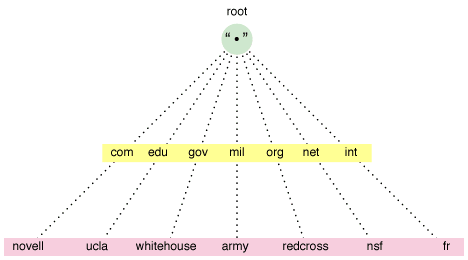Welcome to the fascinating world of Hierarchical DNS! Now, I know what you’re thinking – “Hierarchical DNS? That sounds complicated!” But fear not, my friend, because I’m here to break it down for you in a fun and engaging way. So, grab a cup of coffee, sit back, and get ready to dive into the structure and function of Hierarchical DNS.
So, what exactly is Hierarchical DNS? Well, think of it as the telephone directory of the internet. You know, that big book with all the phone numbers and addresses? Hierarchical DNS serves a similar purpose, but instead of phone numbers, it contains information about domain names and their corresponding IP addresses. It’s like a giant map that helps your internet browser find the right website when you type in a URL.
Now, let’s talk about the structure of Hierarchical DNS. It’s organized in a hierarchical manner, hence the name. At the top of the hierarchy, we have the root domain, represented by a single dot (.), which is the highest level in the DNS hierarchy. Below the root domain, we have top-level domains (TLDs) like .com, .org, and .net. These are followed by second-level domains (SLDs) like google, amazon, and facebook. Finally, we have subdomains, which are specific sections of a website, such as blog.google.com or shop.amazon.com.
In terms of function, Hierarchical DNS works by using a distributed system of servers called DNS resolvers. When you type a URL into your browser, your computer sends a request to a DNS resolver, asking for the IP address associated with that domain name. The resolver then looks up the information in the Hierarchical DNS system and returns the IP address to your computer. This allows your browser to connect to the correct web server and load the website you requested.
So, there you have it – a brief overview of the structure and function of Hierarchical DNS. It may seem complex at first, but once you understand how it works, you’ll appreciate the vital role it plays in navigating the vast expanse of the internet. So, next time you browse the web, remember that behind the scenes, Hierarchical DNS is working tirelessly to ensure you reach your destination smoothly.
The Structure and Function of Hierarchical DNS
Hierarchical DNS (Domain Name System) is a crucial component of the internet’s infrastructure. It organizes domain names into a hierarchical structure, allowing for efficient and reliable domain name resolution. DNS operates through a system of servers, each responsible for a specific level or domain. When a user enters a domain name into their web browser, the DNS system translates it into an IP address, enabling the connection to the desired website. This hierarchical structure ensures scalability and redundancy, making DNS an essential part of the internet’s functioning.

The Structure and Function of Hierarchical DNS
DNS, which stands for Domain Name System, is a fundamental component of the internet that allows users to access websites and other online resources using human-readable domain names instead of numerical IP addresses. Within the DNS architecture, there exists a hierarchical structure that organizes and manages domain names, ensuring efficient and accurate resolution of queries. Understanding the structure and function of hierarchical DNS is crucial for anyone involved in website management, networking, or online security. In this article, we will delve into the intricacies of hierarchical DNS, exploring its layers, components, and the role they play in the smooth operation of the internet.
The Domain Name System: An Overview
The Domain Name System is essentially a distributed database that maps domain names to IP addresses. It serves as a phonebook of the internet, translating user-friendly domain names, such as www.example.com, into machine-readable IP addresses, like 192.0.2.1. This translation is essential for establishing connections and facilitating communication between devices across the internet.
The DNS is designed as a hierarchical system, consisting of multiple levels or layers, each responsible for a specific task. At the top of the hierarchy are the root servers, which hold the authoritative information for the top-level domains (TLDs), such as .com, .org, and .net. Beneath the root servers are the TLD servers, responsible for managing the domain names within their respective TLDs. Further down the hierarchy are the authoritative name servers that handle specific domain names, providing the IP address information necessary for successful resolution.
The Layers of Hierarchical DNS
Root Servers
The root servers represent the highest level of the DNS hierarchy. There are 13 sets of root servers distributed across the globe, each identified by a letter from A to M. These servers are operated by different organizations and are responsible for maintaining the authoritative data for the TLDs. When a user enters a domain name into their browser, the request is initially sent to one of these root servers, which then directs the query to the appropriate TLD server.
Top-Level Domain (TLD) Servers
Below the root servers are the TLD servers, which manage the domain names within their respective TLDs. TLDs can be generic (gTLDs), such as .com, .org, and .net, or country-code (ccTLDs), like .us, .uk, and .de. Each TLD has its own set of servers responsible for handling requests for domain names within that TLD. These servers store information about the domain names registered under their TLD and provide authoritative responses to queries.
Authoritative Name Servers
At the next level of the hierarchy are the authoritative name servers. These servers are responsible for specific domain names and hold the authoritative information about those domains. When a user’s query reaches the authoritative name server, it provides the IP address associated with the requested domain name, allowing the user to establish a connection.
The hierarchical structure of DNS allows for efficient and scalable management of domain names. The distributed nature of the system ensures redundancy and fault tolerance, as multiple servers can handle requests for the same domain name. Additionally, the hierarchical design enables delegation of authority, allowing different organizations and entities to manage specific sections of the DNS.
In conclusion, the hierarchical structure of DNS plays a vital role in the smooth functioning of the internet. From the root servers to the authoritative name servers, each layer serves a specific purpose in the resolution of domain names. Understanding the structure and function of hierarchical DNS is essential for effective website management, network administration, and online security. By grasping the intricacies of this system, individuals can navigate the complexities of the internet with ease and ensure optimal performance for their online endeavors.
Key Takeaways: The Structure and Function of Hierarchical DNS
- DNS stands for Domain Name System, and it is like the phonebook of the internet.
- Hierarchical DNS organizes domain names into a tree-like structure, with the root at the top and branches for different levels of domains.
- The structure allows for efficient and decentralized management of domain names.
- DNS servers store and distribute information about domain names, translating them into IP addresses that computers can understand.
- Understanding hierarchical DNS helps us navigate the internet and access websites by their domain names.
Frequently Asked Questions
What is the hierarchical structure of DNS?
The hierarchical structure of DNS, which stands for Domain Name System, is a way of organizing and managing domain names on the internet. At the top of the hierarchy are the root DNS servers, which contain information about the top-level domains (TLDs) such as .com, .org, and .net. Below the root servers are the TLD servers, which maintain information about specific domain extensions, such as .com or .org. Further down the hierarchy are the authoritative DNS servers, which store information about individual domain names and their associated IP addresses.
The hierarchical structure allows for efficient and scalable DNS resolution. When a user enters a domain name in their web browser, the DNS resolver starts by querying the root servers to find the authoritative server for the TLD. It then queries the TLD server to find the authoritative server for the specific domain. Finally, it contacts the authoritative server to retrieve the IP address associated with the domain name. This hierarchical process helps to distribute the load and ensure reliable DNS resolution.
How does DNS function within a hierarchical structure?
DNS functions within a hierarchical structure by using a distributed network of servers to store and retrieve information about domain names. When a user enters a domain name in their web browser, the DNS resolver first checks its local cache for the corresponding IP address. If the information is not available in the cache, the resolver starts the process of DNS resolution.
The resolver sends a query to the root DNS servers, requesting information about the TLD associated with the domain name. The root servers respond with the IP address of the TLD server. The resolver then sends a query to the TLD server, requesting information about the authoritative server for the specific domain. The TLD server responds with the IP address of the authoritative server. Finally, the resolver sends a query to the authoritative server, requesting the IP address associated with the domain name. The authoritative server responds with the IP address, and the resolver can then connect the user to the desired website.
What are the advantages of the hierarchical structure of DNS?
The hierarchical structure of DNS offers several advantages. Firstly, it allows for efficient and scalable DNS resolution. By distributing the workload across multiple servers, the hierarchical structure ensures that DNS queries can be processed quickly and reliably, even with a large number of domain names and users.
Secondly, the hierarchical structure enables a decentralized system of domain name management. Each level of the hierarchy is responsible for maintaining and updating the information within its domain, reducing the burden on individual servers and increasing the overall resilience of the DNS system.
Are there any limitations to the hierarchical structure of DNS?
While the hierarchical structure of DNS has many benefits, it also has some limitations. One limitation is the potential for bottlenecks or delays in DNS resolution. If a root or TLD server becomes overloaded or experiences technical issues, it can slow down the entire DNS resolution process.
Another limitation is the possibility of DNS cache poisoning or spoofing attacks. Since DNS relies on the information stored in the cache of DNS resolvers, an attacker could potentially manipulate the cache to redirect users to malicious websites. Efforts are made to mitigate these risks through security measures such as DNSSEC (Domain Name System Security Extensions).
How does the hierarchical structure of DNS impact internet browsing?
The hierarchical structure of DNS plays a crucial role in internet browsing by ensuring that domain names can be translated into IP addresses and users can access websites. Without DNS, users would need to remember and enter the IP addresses of websites directly, which would be impractical and inconvenient.
The hierarchical structure allows DNS resolution to be performed quickly and efficiently, enabling users to access websites by simply entering domain names in their web browsers. It also allows for the scalability of the DNS system, accommodating the ever-expanding number of domain names and internet users.
How a DNS Server (Domain Name System) works.
Final Thought: The Power of a Hierarchical DNS Structure
After diving into the intricacies of the hierarchical DNS structure, it becomes clear that this system plays a vital role in the functioning of the internet. By organizing domain names in a hierarchical manner, DNS enables efficient and reliable communication between devices across the globe. This not only ensures that websites and online services are easily accessible but also contributes to the overall stability and security of the internet.
One of the key advantages of a hierarchical DNS structure is its scalability. As the internet continues to grow at an exponential rate, this hierarchical arrangement allows for the management and resolution of an ever-increasing number of domain names. By distributing the workload across multiple levels of DNS servers, the system can handle vast amounts of traffic and maintain optimal performance.
Moreover, the hierarchical nature of DNS enables faster and more efficient domain name resolution. As requests travel from the local resolver to the authoritative DNS servers, the hierarchical structure allows for quick navigation through the various levels of the DNS hierarchy. This streamlined process minimizes latency and ensures that users can access websites and online resources with minimal delay.
In conclusion, the hierarchical DNS structure serves as the backbone of the internet, providing the foundation for efficient and reliable communication. By organizing domain names in a hierarchical manner, DNS facilitates speedy resolution and ensures that users can access websites and online services seamlessly. As the internet continues to evolve, the hierarchical DNS structure will remain a crucial component, enabling the smooth functioning of the digital world.






